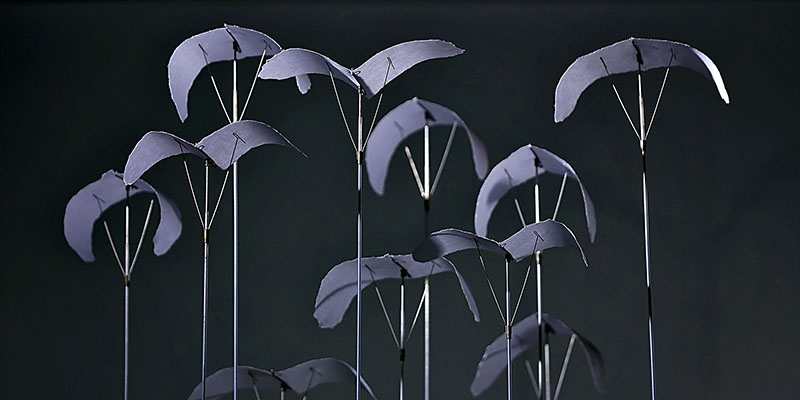Kinetic Sculptor Arthur Ganson has been perfecting his art since 1977. His work is extremely unique and has been exhibited in numerous galleries and museums in the U.S. and Europe, including the MIT Museum and The Exploratorium in San Francisco.
The New York Times and Smithsonian have covered Ganson’s inventions. These creations, rather than serving purely practical purposes, are driven by his desire to “make you think about things.” Here at Ozobot, we also want to motivate kids (and adults!) to create things that even they may not understand yet. We wanted to pick Ganson’s brain on what motivated him to become an artist and engineer, how technology is an important part of his career, and what projects he is currently excited about.
Tell us about a project you’re excited about right now—yours or someone else’s.
I’m excited about many things right now. Most immediately, I’m just about completed with a piece called “Beholding the Big Bang” in which a motor drives a series of gears which reduce the motor speed such that the final gear will take 13.82 billion years to rotate once. This is one of the estimates for the age of the Universe since the big bang. The final gear will, in practice, never turn, so it is firmly embedded in a block of concrete!
This presses the point visually. The motor is present time with all that is going on. The concrete is stillness—perhaps the imaginary moment before everything happened. I’m also collaborating with my wife, Chehalis [Hegner], and son, Cat, on a piece which is based somewhat on the 12 stations of the Cross in the Catholic faith. Besides all of that, I’ve got about a zillion other invention and sculpture ideas. And besides all of that, I’m deeply invested in learning to speak with my 5 string electric violin—which I built and am continually developing.
What motivated you to be an artist who also practices engineering? Did the education system nurture that interest, or did you have to take matters into your own hands?
My motivation to use engineering evolved because I’ve always been primarily interested in movement. When I started to make sculpture I naturally moved away from static work to kinetic work. To make something move one must address engineering concerns. I have never formally studied engineering. I’ve always learned by doing—making things and then assessing the result. My school supported my early explorations into wire engineering because I was pretty serious about it all.
How do you use technology in your work? How do you want to be using technology 10 years from now?
There is technology on every level with everything that I have ever done. Beginning with wire, I have developed tools and techniques specific to that material—and it continues to evolve.
Besides that, I build machines with “real” parts (i.e. gears from catalogues, motors, etc.). Recently, I have begun to learn 3D modeling (specifically I’m using Autodesk’s Fusion 360). This is allowing me to design in new and very interesting ways. I have many ideas for pieces which will be 3D printed or machined with CAD tools.
It’s also now possible to expand the workshop to literally the world! All of these things will be ongoing for at least the next 50 years (I’m 62 now). The power of designing with a computer and all related capacities (CAD tools and communication) is staggering.
You get to have one conversation with your teenage self. What advice do you give him?
Interesting question. I would tell that 16 year old that he does not have to be anything particular for anyone else, and that even though nobody has ever inquired about what was going on inside, his internal truths are valid and real. I would also tell him that it is not only okay, but important for him to take care of his own needs!
How important is collaboration to your work? Who have you collaborated with recently?
As I mentioned above, I am currently working on an extensive collaboration with my wife and son. Chehalis is primarily a photographer and my son Cat is a filmmaker/writer/model/all around creative soul. The process of working together is rich and expansive because the work touches every aspect of who we are. The overview is that we will make 14 machine/photographs, all linked and powered by a viewer. We’re at the beginning of the project and it may take a few years to complete.
Many years ago, I collaborated with a movement/theatre group to create a play, Shadow of a Doubt, in which there were both actors and giant machines on stage. I was also one of the actors. When collaborations work they can be very rewarding. In general however I do most of my work in solitude!
Arthur Ganson received his BFA degree at the University of New Hampshire in 1978. Besides making and exhibiting sculpture, he occasionally teaches classes in mechanics and wire bending. For the past 18 years he has been the ringleader of the MIT Museum’s Friday After Thanksgiving Chain Reaction, a community event in which families and students of all ages assemble a giant chain reaction. He is also the inventor of the children’s toy Toobers and Zots.
Featured image: Arthur Ganson, Machine with 11 Scraps of Paper. Image credit: Copyright 2016. Chehalis Hegner. All rights reserved.









